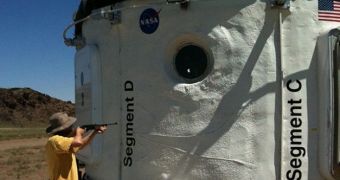While in space, astronauts and cargo are at some risk of being struck by various impactors, including space junk or micrometerorites. Now, experts propose the development of a new type of sensors, that would literally listen for the sounds such impacts would make.
This would help astronauts on the International Space Station (ISS), for example, who have a lot of ground to cover, and can't be in all places at once. The facility is also very large, which means that space flyers will have to act rapidly when emergencies take place.
If they are caught on the wrong foot, then they could very well die. The same holds true for crews manning the space shuttles, or the Soyuz space capsules. In the future, the NASA Orion Multi-Purpose Crew Vehicle (MPCV) could be subjected to the same risks.
The latter is being developed to reach a near-Earth asteroid by 2025, and Mars by the mid-2030s. This is a very ambitious plan, considering the huge amount of innovation that will have to be achieved in order to make this possible.
Things will naturally be most dangerous in orbit around Earth. The area is clogged with tens of thousands of pieces of space debris larger than an inch, with countless more smaller than that. These pieces can travel at speed 20 times higher than that of a speeding bullet.
“They are extremely dangerous to astronauts and can destroy spacecraft. Anything 50 microns and above is dangerous,” explains Virginia Polytechnic Institute (VPI) space physicist Frank Giovane.
“An acoustic sensor can detect impacts from particles down to 5 microns or so,” he goes on to say. Such a sensor was first tested in Arizona, during the 2010 Desert Research and Technology Studies.
It was installed on the NASA Habitat Demonstration Unit, and then researchers fired air guns at the structure, in order to simulate the acoustical characteristics of a micrometeorite impacting a spacecraft.
At the end of the trials, the sensor proved to be 100 percent effective, identifying all 147 impacts that the research team caused. It was also very accurate in terms of locating where the projectiles hit. The margin for error was 3 inches (8 centimeter), Space reports.
All the details related to the investigation were presented on May 26, at the meeting of the Acoustical Society of America, in Seattle. Experts say that practical applications are only a very short distance away.

 14 DAY TRIAL //
14 DAY TRIAL //